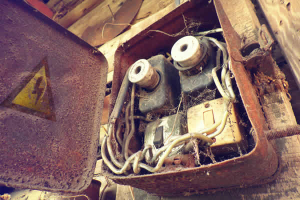
24 Jun, 2020
When it comes to household electrical systems, your safety is paramount. Flickering lights, high bills, and damaged appliances can all be signs of old house electrical problems.
As a homeowner, you should focus on making improvements as early as possible if you really want to make your home safe and secure. In this article, you’ll find some common electrical problems you might face in your old or heritage house, and their solutions.
Here are a few common electrical problems in old homes that we’ve identified in our nearly 40 years of running an HVAC Fargo business:
This could be a sign of a poor connection and can lead to eventual arcing. Loose or corroded connections can make intermittent contact that could result in sparking, overheating, and fire.
If you’re experiencing frequent bulb blowouts, it could be more serious than overuse. You may have a loose connection in the socket or circuit. If recessed lights are frequently failing, nearby insulation could be causing overheating. These fixtures are designed to shut off to prevent fire.
Dead outlets can result from a tripped poor connection (and possible arcing), or a tripped breaker due to excessive heat buildup, resulting in melted wires or outlets. How to fix a dead outlet? Your outlet might be dead because the fuse blew or the breaker tripped. Go to the electrical panel, find and replace the blown fuse or tripped breaker.
Unless it is a dimming switch, warm outlets are a serious safety concern and should be addressed by a professional immediately.
This is usually a sign that the circuit is overloaded and using excessive electricity. You may want to consider adding a circuit or upgrading your electrical service.
Overlamping is when a light fixture has a bulb with a higher wattage than the fixture is designed for. The bulb's intense heat can scorch or melt the socket and insulation on the fixture's wires, which increases the risk of arcing.
Another major source of electrical problems is the old house electrical wiring. The wiring inside many houses is obsolete, straining to supply our ever-increasing assortment of power-hungry appliances, lighting, and electronics. The circuits in older homes aren't designed to power the many gadgets of modern life.
Some electrical appliances, such as hairdryers, can frequently trip or short circuits. If you are experiencing short circuits without the appliance, there could be a short in the wiring or receptacle, which needs to be addressed by a pro.
Old houses often have a limited number of outlets, which means heavy reliance on extension cords and power strips. These extension sets have certain load capacities that limit the number of devices they can power simultaneously. Plus, extension cords are susceptible to cuts and damage.
How to check house electrical wiring? Want to add new wiring in an old house? Here are a few safe and affordable solutions to prevent common old house electrical problems:
Consider adding more power sockets all around your house. It’s best to plug in your appliances directly into these outlets instead of via an extension cord. More hands-on sockets mean more regions where you can securely place your appliances. This allows them to get the essential amount of electricity without any hazards or turbulences in the system.
Don’t leave extension sets on the floor when they’re in use. Keep them either concealed or visible enough so that passers-by are aware of their presence. You don’t want people stumbling on these cords. Not only will it cause injury, but it might also harm your appliances. In case the extension set is to be used for a long time, hide the cord on the floor with an electrical tape. This way, people are less likely to trip on it.
Lack of ground-fault circuit interrupters (GFCIs) means increased risk of electrocution in wet areas, such as baths and kitchens. GFCIs shut down circuits in 4 milliseconds, before current can cause a deadly shock. So, consider replacing your old receptacles with GFCIs.
Don’t be a DIY daredevil. If electrical issues in the home are ongoing, you should consider contacting an electrician. Safety around the home is of utmost importance, so get in touch with a professional to help diagnose the electric issues. House inspection team will assess and fix your home electrical systems, giving you peace of mind and safety assurance.
Whether you’re building a new home, remodeling your old house, or simply replacing your cooling system, Valley Service is your all-in-one HVAC and plumbing service provider. With courteous and professional technicians, our efficient and cost-effective solutions can help to keep your home comfortable. Call us today to book our Fargo HVAC or plumbing services, or send us a message via our online form.